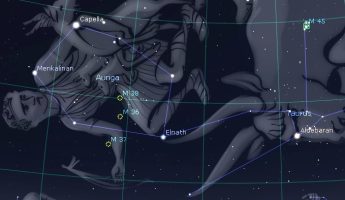This Week’s Sky at a Glance, 2025 Oct 25 – Nov 1
This Week’s Sky at a Glance, 2025 Oct 25 – Nov 1
Open clusters, sometimes called galactic clusters, are groups of relatively young stars (usually less than 500 million years old) that formed from the same vast cloud of gas and dust. The Pleiades cluster (M45) in the shoulder of Taurus the Bull is seen easily with the naked eye because it is fairly close at 440 light years (mind you, a light year is 9.5 trillion kilometres). The V-shaped Hyades in the face of Taurus is the closest at 150 light years, although Aldebaran at one end of the V is actually a foreground star at a distance of 65 light years. Many other clusters are greater than ten times farther and require binoculars or a telescope to be seen at all, usually as a hazy patch with some individual stars.
To the left of Taurus is a pentagram of stars marking the head, shoulders and knees of the constellation Auriga the Charioteer. One of those stars – in Auriga’s right knee, with him facing us – is officially part of Taurus. Point your binoculars halfway between this star and the one in Auriga’s right shoulder. Open cluster M36 is just inside the line between the stars, and M37 is just outside. They look like fuzzy patches because, at distances of greater than 4000 light years, a telescope is required to resolve individual stars. Further inside is the diffuse open cluster M38, midway between the right shoulder and left knee. All three clusters can be seen together in wide-field binoculars
This Week in the Solar System
Saturday’s sunrise is at 7:54 and sunset will occur at 6:21, giving 10 hours, 27 minutes of daylight. Next Saturday the Sun will rise at 8:03 and set at 6:11, giving 10 hours, 8 minutes of daylight.
The Moon is at first quarter on Wednesday and nearing Saturn next weekend. Mercury is at greatest elongation Wednesday, low in the southwest with Mars a binocular width to its right and setting 45 minutes after sunset. Saturn is highest and best for observing around 10:30 pm, and Jupiter rises below the Gemini Twins a half hour later. Venus rises in the east around 6:30 am when Jupiter is at its highest to the south. Rural observers might see the zodiacal light in the morning sky 90 minutes before sunrise, a subtle wedge of scattered sunlight angling up toward Jupiter. Over the week binocular comet 2025 A6 Lemmon scoots from Bootes to Ophiuchus, about 20 degrees above the western horizon at 8 pm. See the Heavens Above website for its location at any time.
The Saint John Astronomy Club meets in the Rockwood Park Interpretation Centre on November 1 at 7 pm. Tune in to the Sunday Night Astronomy Show at 8 pm on the YouTube channel and Facebook page of Astronomy by the Bay.

